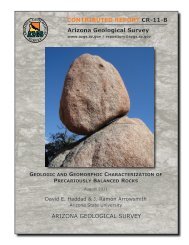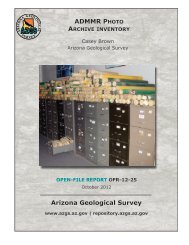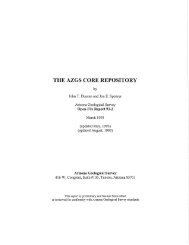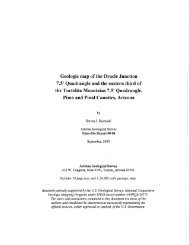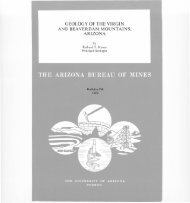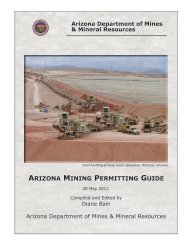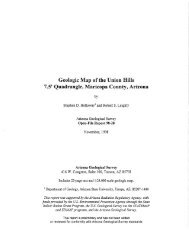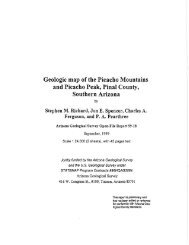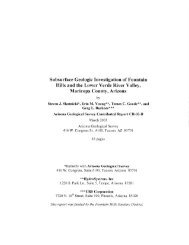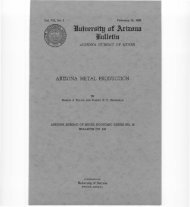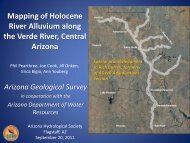Arizona has Salt! - 41 p. - AZGS Document Repository
Arizona has Salt! - 41 p. - AZGS Document Repository
Arizona has Salt! - 41 p. - AZGS Document Repository
You also want an ePaper? Increase the reach of your titles
YUMPU automatically turns print PDFs into web optimized ePapers that Google loves.
------------------------<br />
<strong>Arizona</strong> Has <strong>Salt</strong>!<br />
minerals include sylvite, carnallite, and polyhalite. There<br />
<strong>has</strong> been no solution mining or commercial production of<br />
potash even though exploration drilling in the 1960s and<br />
1970s indicated a potential ofas much as 285 million tons<br />
ofnearly 20 percent average grade KzO.<br />
Verde Valley<br />
Transition Zone<br />
The Verde Valley is in northeastern Yavapai County<br />
about 30 miles south-southwest of Flagstaff (Figure 6).<br />
This northwest-trending valley, about 30 miles long and<br />
10 miles wide, is a halfgraben bounded on the southwest<br />
by the Verde fault. The Verde Valley, located within the<br />
Transition Zone, does not attain the great depth to<br />
bedrock that is common in the basins in the Basin and<br />
Range Province. Richard and others (2000) show the<br />
800 ft depth-to-bedrock contour in the valley but not the<br />
4800 ft contour. The well-location map of Yavapai<br />
County (Koester, Conley, and Rauzi, 1995b) lists five<br />
significant wells in the Verde Valley. These wells provide<br />
little useful information. Four ofthe wells are within the<br />
800 ft depth-to-bedrock contour. Although no distinct<br />
trends are apparent on the residual gravity values<br />
(Prescott and Holbrook Sheets - Lysonski, Aiken, and<br />
Sumner, 1981), a small elongate gravity low is present<br />
within an area ofwidely spaced gravity contours justwest<br />
of Camp Verde. Another elongate gravity low is present<br />
10 miles north of Camp Verde. A natural gas pipeline<br />
extends eastward from the Maricopa Crossover into the<br />
northwestern part of the Verde Valley. No major railroads<br />
are present in the valley.<br />
Blake (1890) published the first detailed description<br />
of salts, including halite, in the Verde Valley. The evaporite<br />
deposits described by Blake are associated with the<br />
mudstone facies of the lacustrine Verde Formation of<br />
Tertiary age and extend over an area of about 75 mi 2 in<br />
the southwestern part of the valley (Twenter and<br />
Metzger, 1963, p. 47). The evaporite deposits probably<br />
formed in isolated ponds bordering the restricted lake<br />
during dry periods. Halite is more common nearer the<br />
southwest-bounding fault. Nations (1974, p. 615)<br />
reported a composite thickness ofmore than 3100 ft for<br />
the Verde Formation. The maximum thickness of the<br />
Verde Formation <strong>has</strong> not been determined.<br />
The salt mine described by Blake (1890) is about 1.5<br />
miles southwest of Camp Verde in 1-13n-4e. The Verde<br />
Formation at the salt mine contains beds of sodium sulfate<br />
(thenardite, mirabilite, and glauberite) with thinly<br />
bedded halite. These deposits cover several acres in<br />
extent and reach a thickness of60 ft or more. Gypsum is<br />
the chief mineral at a gypsum quarry in 11-13n-5e,<br />
about 6 miles east-southeast of the salt mine. Twenter<br />
and Metzger (1963, p. 76) reported that water from wells<br />
in the mudstone facies south of Camp Verde was small<br />
10<br />
in quantity and very salty. In addition, salt was reported<br />
in two wells, the Verde Oil Company #1 in 14-13n-Se<br />
and a water well in 28-13n-5e. The Verde Oil #1 was<br />
drilled to a depth of 1625 ft in 1913. Verde Oil reported<br />
several beds of salt between 170 and 860 ft and water at<br />
1000 ft that contained 33 percent sodium. Twenter<br />
reported evaporite minerals between 160 and 700 ft in<br />
the water well (Twenter and Metzger, 1963, p. 77). He<br />
reported salt, salty taste, and a white, crystalline crust<br />
forming on dry samples between 160 and 360 ft. The<br />
water well is about 3 miles southwest of the Verde Oil<br />
#1.<br />
The salt mine and wells in the mudstone facies south<br />
of Camp Verde are just southeast ofthe elongate gravity<br />
low west of Camp Verde in the central to southeastern<br />
part ofT. 14 N., R. 4 E. This gravity low may represent<br />
thicker deposits of salt along the Verde fault, which<br />
bounds the southwest margin the Verde Valley. Another<br />
gravity low is present 10 miles north of Camp Verde.<br />
The areal extent ofevaporites in the northern part ofthe<br />
Verde Valley is not known and the limited subsurface<br />
information indicates that evaporite sediments did not<br />
extend that far north (Nations and others, 1981, p. 146).<br />
Even so, the elongate gravity low north of Camp Verde<br />
in the northeastern part ofT. 15 N., R. 4 E. may represent<br />
a salt deposit formed in one of the isolated ponds<br />
bordering the restricted lake during dry periods. No deep<br />
holes have been drilled to verifY the presence ofthe mudstone<br />
facies or discount the possibility of evaporite<br />
deposits and salt. ADWR records indicate that hundreds<br />
of domestic water wells have been drilled to depths of<br />
less than 300 ft in this part ofthe Township. The deepest<br />
well was drilled to a depth ofonly 930 ft in 1-15n-4e.<br />
Detrital Valley<br />
Basin and Range<br />
Detrital Valley is a long, linear valley that trends<br />
northwesterly for about 40 miles between Dolan Springs<br />
and Lake Mead in northern Mohave County (Figure 7).<br />
The valley widens to about 15 miles at its southern end<br />
near Dolan Springs where it attains its maximum depth<br />
of at least 4800 ft (Richard and others, 2000). The welllocation<br />
map of Mohave County (Koester, Conley, and<br />
Rauzi, 1996b) lists 19 significant wells in Detrital Valley.<br />
All are considerably north of the 4800 ft depth-tobedrock<br />
contour west of Dolan Springs. Residual gravityvalues<br />
decrease steadily from Lake Mead into an elongate<br />
gravity low just southwest of Dolan Springs<br />
(Kingman Sheet - Lysonski, Aiken, and Sumner, 1981).<br />
Two interstate gas pipelines and a major railroad extend<br />
westerly through Kingman, about 25 miles south of<br />
Dolan Springs.<br />
Detrital Wash flows· northward through Detrital<br />
Valley into the Colorado River (now Lake Mead). North



